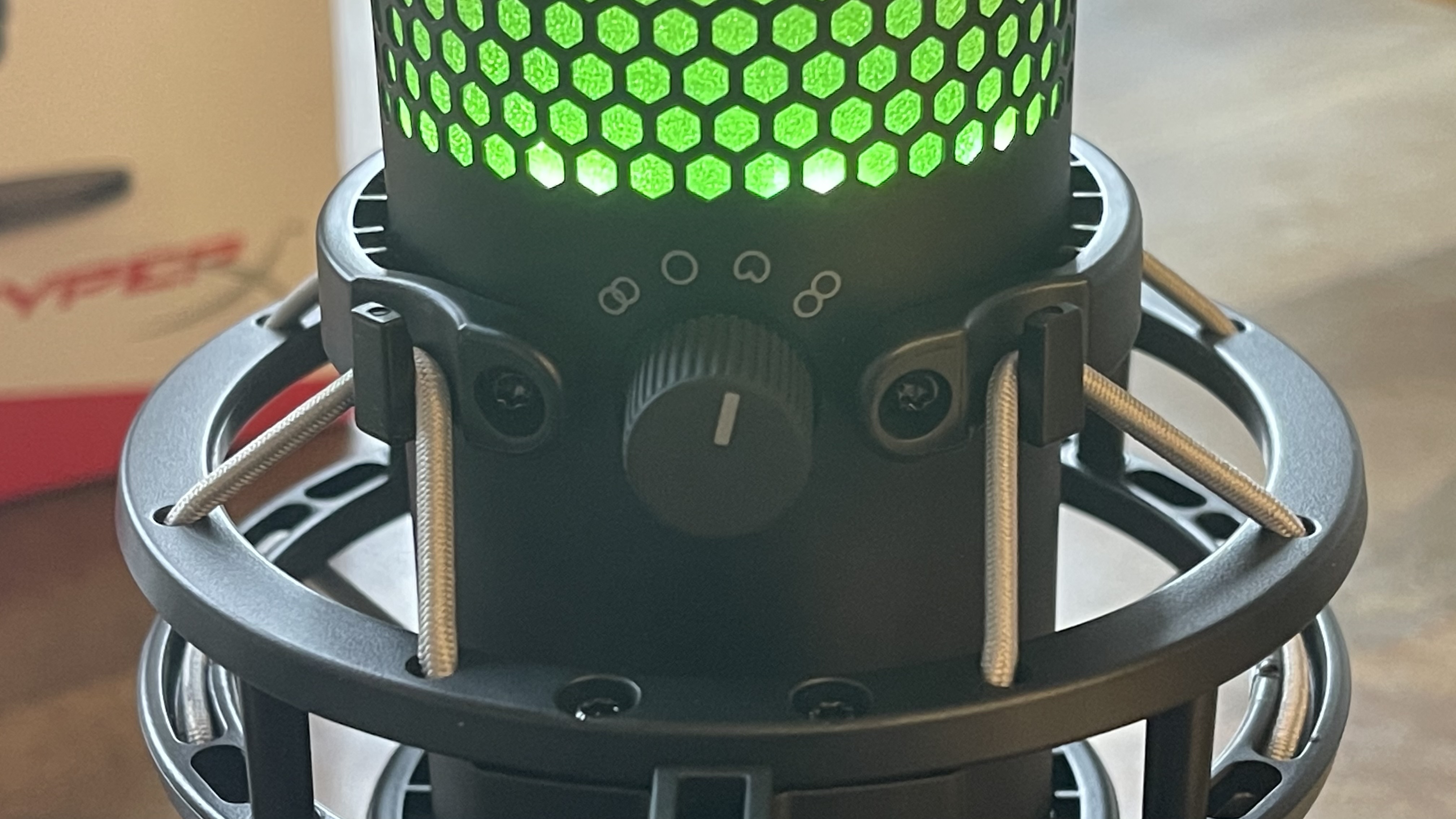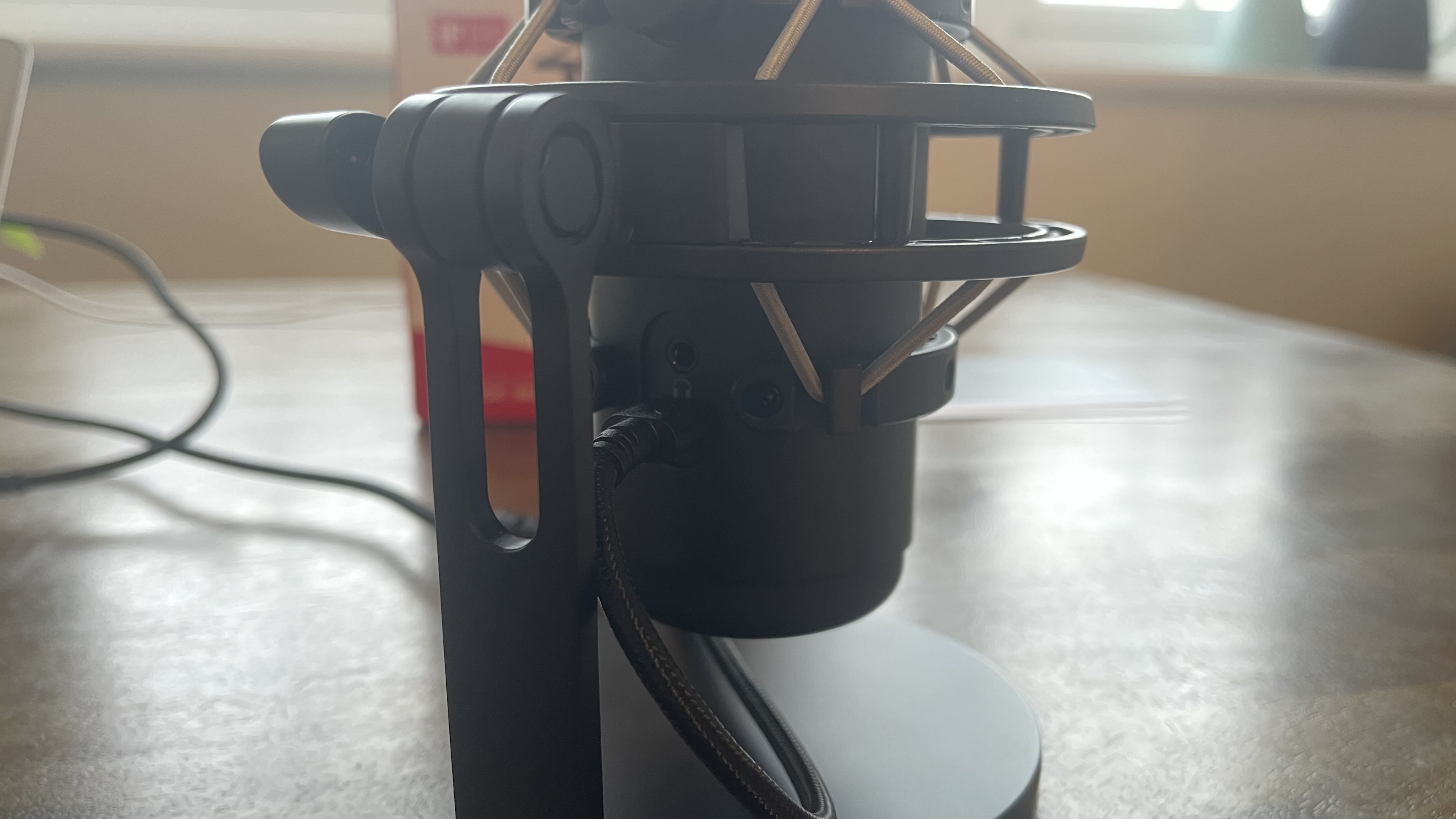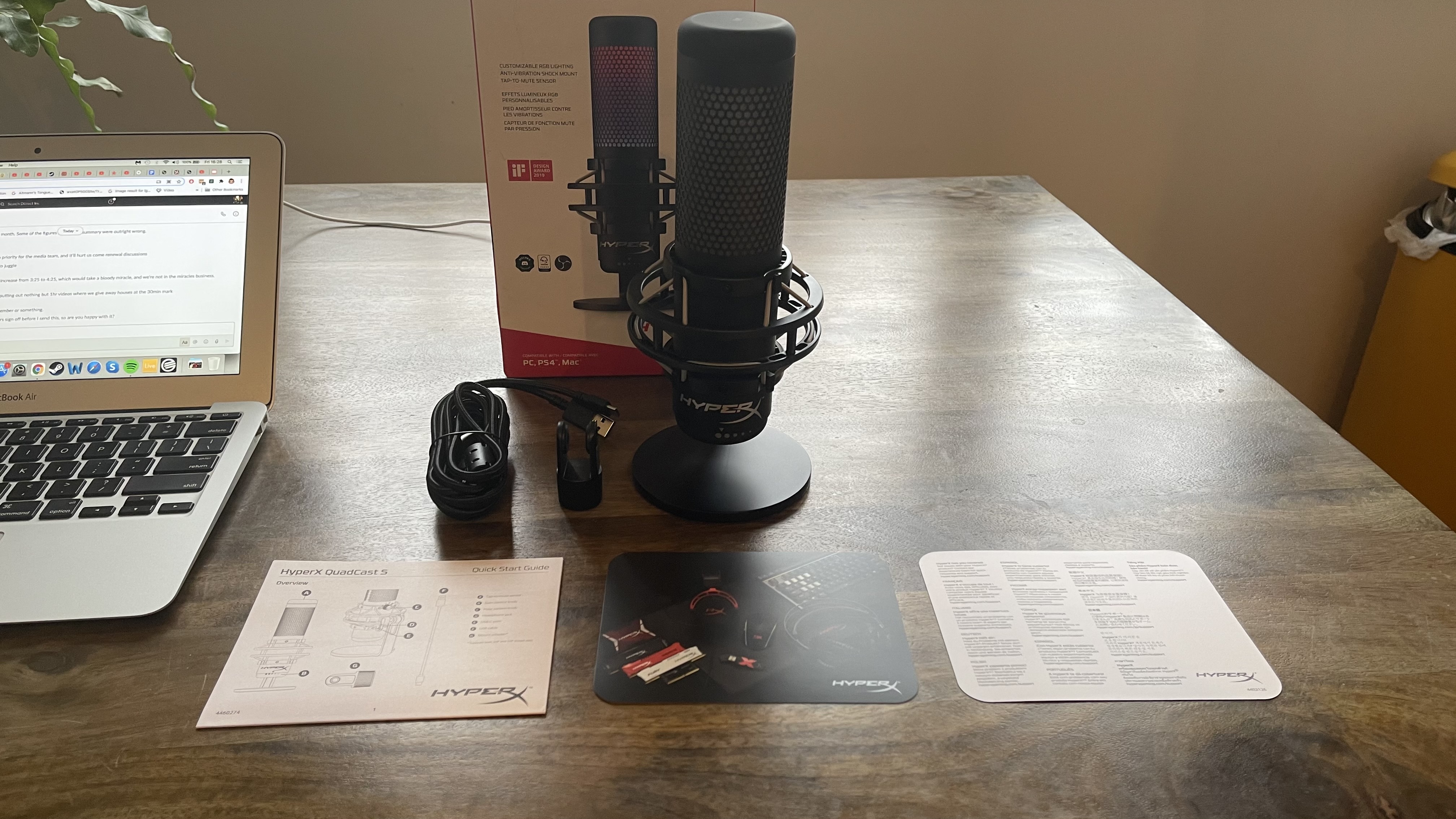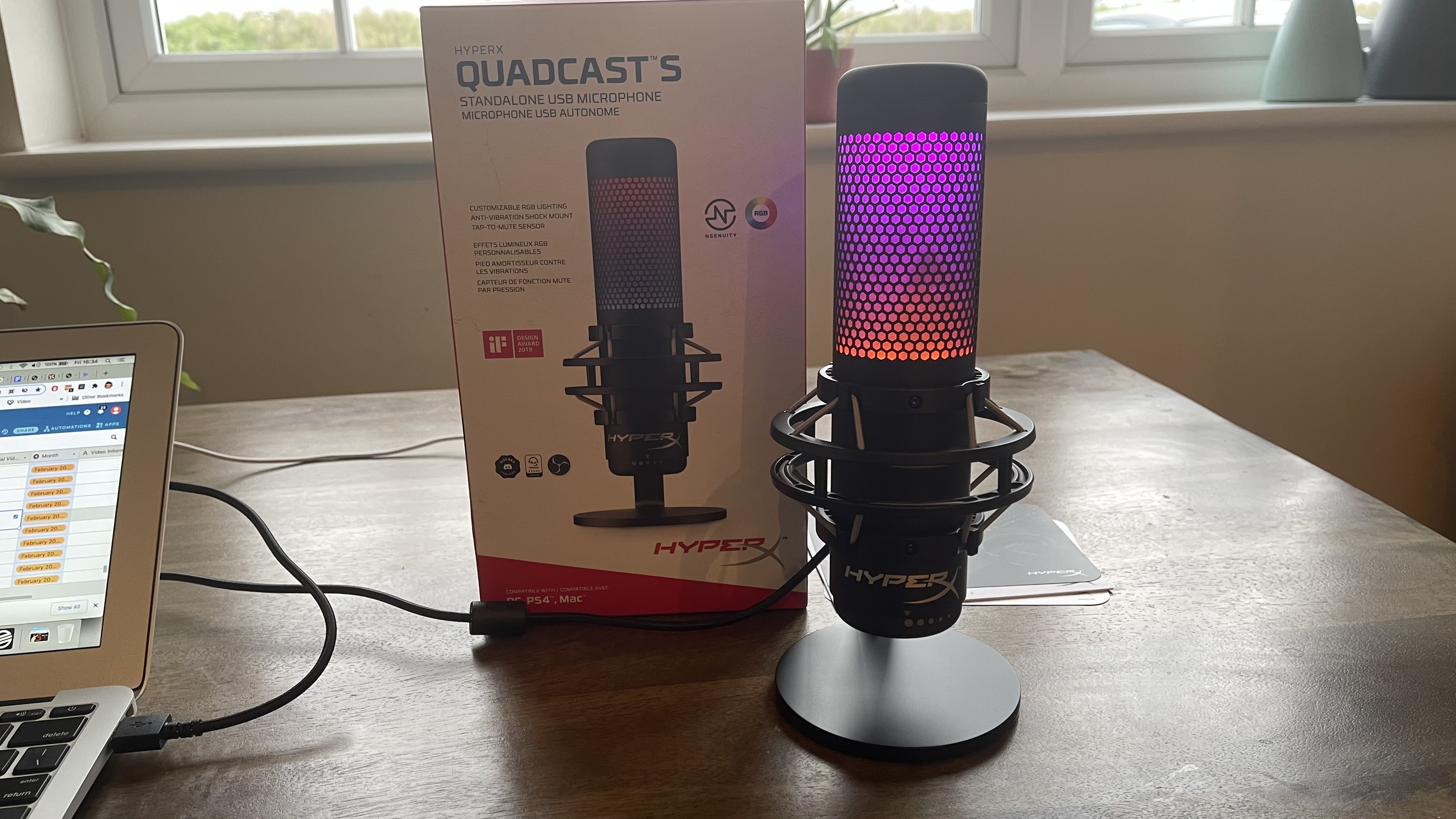Tom's Hardware Verdict
Now with RGB, the QuadCast S is great in all the same ways the original model was but with flashing lights. If that’s essential for your streaming setup aesthetic that’s great news. For everyone else, the sound quality and polar options are the big pull.
Pros
- +
+ Very useful shock mount
- +
+ Superior build quality
- +
+ Sounds as good as similarly priced competitors
- +
+ Four polar patterns
Cons
- -
Not much different from original QuadCast
- -
Software needed to turn RGB off
- -
Not quite a studio mic
Why you can trust Tom's Hardware
In the upper echelons of streamer mic, it seems, there are two ways to play it. The first is to emulate the look and feature set of analog recording mics as closely as possible and rely on the convenience of that USB input as a selling point. The Beyerdynamic’s Fox is the gold standard for this approach, for example. The second approach is to go all-in on the gamer appeal. Guess which approach the HyperX QuadCast S ($160 as of writing) opts for?
It only takes the time for the power to make its way along the USB cable and up to that huge RGB lighting zone to figure that one out. This refresh of the existing HyperX QuadCast, which had been one of the best gaming microphones, is meant to give the likes of Razer’s Seiren Emote a run for its money on pure streamer setup aesthetic appeal. But if you look beyond all the flashing color there’s actually plenty here in common with more studious studio mics too. A lot of it inherited from the original Quadcast, we hasten to add. Don’t lose sleep if you bought the original just before this S variant came out. You’re not missing out on anything other than potential migraines; the specs are nearly identical.
If you weren’t already a QuadCast owner though and are looking for a serious USB mic, there’s a lot to like in the QuadCast S.
HyperX Quadcast S Specs
| Frequency Response Range | 20 Hz - 20 KHz | Row 0 - Cell 2 |
| Sample / Bitrate | 48 kHz / 16-bit | Row 1 - Cell 2 |
| Polar Patterns | Stereo, omnidirectional, cardioid, bidirectional | Row 2 - Cell 2 |
| Headphone Amplifier Impedance | 32 Ohms | Row 3 - Cell 2 |
| Dimensions (extended in stand, LxWxH) | 4 x 4 x 9.5 inches | Row 4 - Cell 2 |
| Weight (microphone only) | Microphone: 0.6lbs (254g) | Row 5 - Cell 2 |
| Extra | Removable stand, shock mount, RGB lighting, headphone monitoring | Row 6 - Cell 2 |
Design
The QuadCast S is far from a drastic redesign of the original QuadCast, but there are differences. Small ones. The elasticated cord around the QuadCast S’ shock mount is now gray instead of the original red, for example, and the USB input connection is now USB Type-C instead of USB Type-A. We did say they were small differences.



Otherwise, you’re looking at the same unit. You get a large capsule housing three separate diaphragms to offer four polar patterns and a dial to switch between them at the back, a headphone monitoring input below that, a touch-sensitive mute at the top and a smooth and satisfying gain control dial at the base of the mic.
We’ll tackle the different patterns and the sounds they create below in the sound quality section, but let’s cover those other design features. The QuadCast S’ headphone monitoring is clear and doesn’t run too hot for higher gain settings, so there’s very little breakup until you start shouting or getting close to the capsule.
As with the QuadCast and HyperX SoloCast, the QuadCast S’ mute touch button is a nice design that alleviates that audible popping sound you sometimes get from depressing a physical mute switch on other mics. Meanwhile, the mute button’s lighting leaves you in no uncertainty as to whether you’re muted or not.
Get Tom's Hardware's best news and in-depth reviews, straight to your inbox.
The gain control feels really well built, but its travel considerably exceeds the visual indicators on each side. So unless you like your output set at between 30%-70%, you won’t be able to get a visual on your preferred setting.
Sound Quality
The QuadCast S is a refresh of an existing mic, so you know what’s coming: The sound characteristics are unchanged, as far as these ears can discern.
And they didn’t need to change. Boasting four polar patterns and three separate mic membranes was something of a party trick for the original QuadCast, so much so that it obviously informed the product name. And while the Blue Yeti X can tick those same polar pattern boxes, there was a gulf in sound quality between the two. So it goes with the QuadCast S we’re reviewing.
There are a couple of provisos, though. Our first is that the QuadCast S comes frustratingly close to being a good low-budget studio mic with all those polar patterns, but since it’s limited to 48K Hz/16-bit recording, it doesn’t quite spread its wings and get there. 48KHz/16-bit is ample for a streamer mic’s intended usage, of course, where the audio will either be heavily compressed at the source or by the platform. But if you have a stereo / omnidirectional / cardioid / bidirectional mic available to you, perhaps you’d be tempted to use it for some home recording and music production. In those situations, it’s nice -- not essential, but nice -- to have a higher sample rate and bitrate to play with.
Today’s high-end streamer mics all exist within a very narrow gamut with ready-to-go-audio, and the QuadCast S fits the profile. Like Razer, Elgato and cheaper Blue models, there’s definitely a slightly scooped EQ hat boosts low mids, suppresses mids and accentuates high-end frequencies for clarity of speech. That means your recordings sound professional, rather than natural; the mic is doing a bit of EQ and compression for you.
Blue’s Yeti X still offers the happiest compromise between natural and broadcast-ready to our ears compared to the QuadCast S and other high-end mics, but these are fine margins between models we’re talking about.
Features and Software
You know the drill by now with RGB devices. Cometh the lights, cometh the accompanying software app. In this case, it’s HyperX’s NGenuity software that acts as a gateway to customizing the QuadCast S’ two lighting zones (top and bottom), colors and behavior, and it makes doing so pretty simple.
There’s not much tweaking to be had on the audio side though. Gain, mic monitoring and headphone volume are controllable via software, but there are no EQ presets or noise cancellation options. Small footprint software is a plus for some people, of course, but if you were looking to sculpt the mic’s sound without going into a DAW and applying plugins, you should look elsewhere.
For anyone resistant to installing yet another peripheral manufacturer’s app onto their C:/ (this reviewer included), it’s worth noting that customizing RGB behavior is just about the only thing you can’t do without NGenuity installed. You can do everything else, from muting to choosing polar patterns, with physical dials on the unit. That may sound like a given, but with some budget mics, like the Razer Seiren Mini, jettisoning all physical controls, perhaps it’s worth stating explicitly. That leaves the physical unit much more feature-rich than the software, which does its best to act useful when you load it up. But when part of the screen’s devoted to showing you which settings you’ve already selected using physical controls, (such as the polar pattern), you get a clear sense that this isn’t essential software.
Bottom Line

The HyperX QuadCast S brings a gamer-fied aesthetic to the already great mix available in the HyperX QuadCast, with flexibility and out-of-the-box sound quality. There’s not much to complain about, but if you have the standard QuadCast there’s not much to get excited about either.
If you’re specifically drawn to the QuadcCast S for its four polar patterns and the potential for home recording, consider an analog XLR mic or the Beyerdynamic Fox for its higher sample and bitrate.
If you’re happy to keep things CD-quality when you’re recording however, the QuadCast S will see you right.